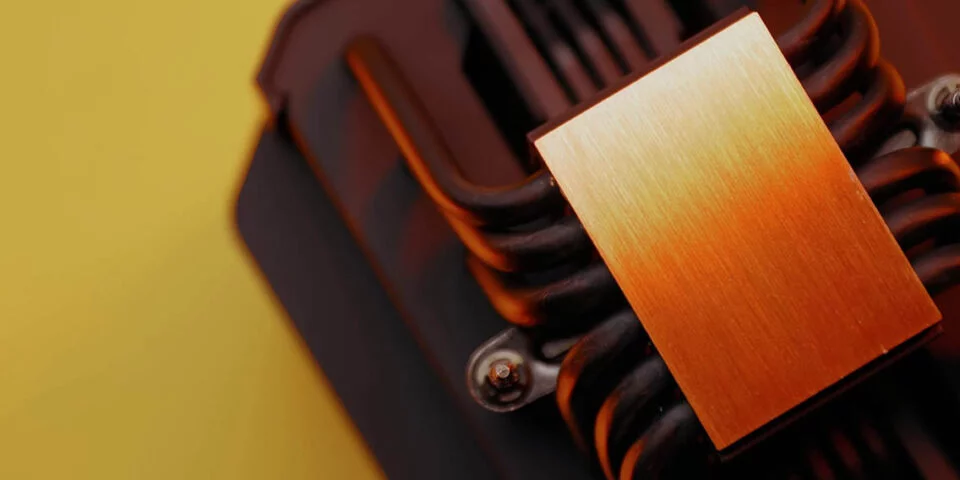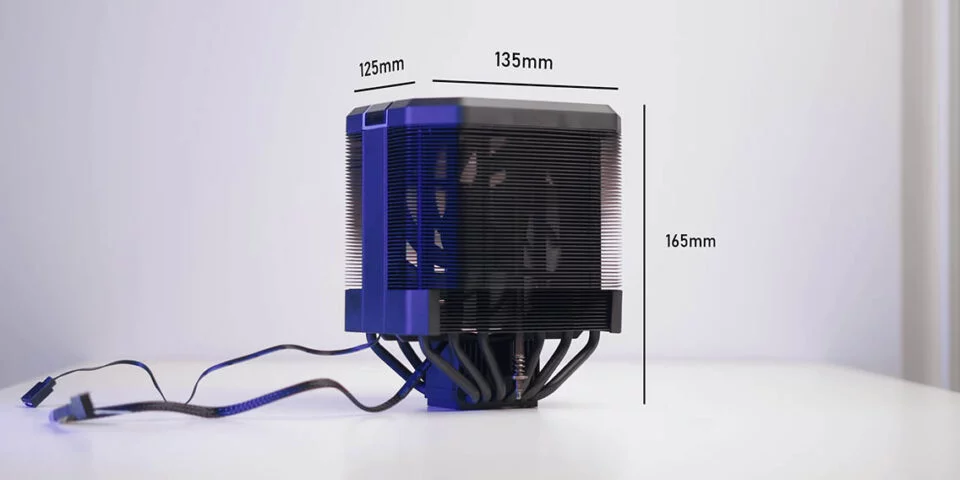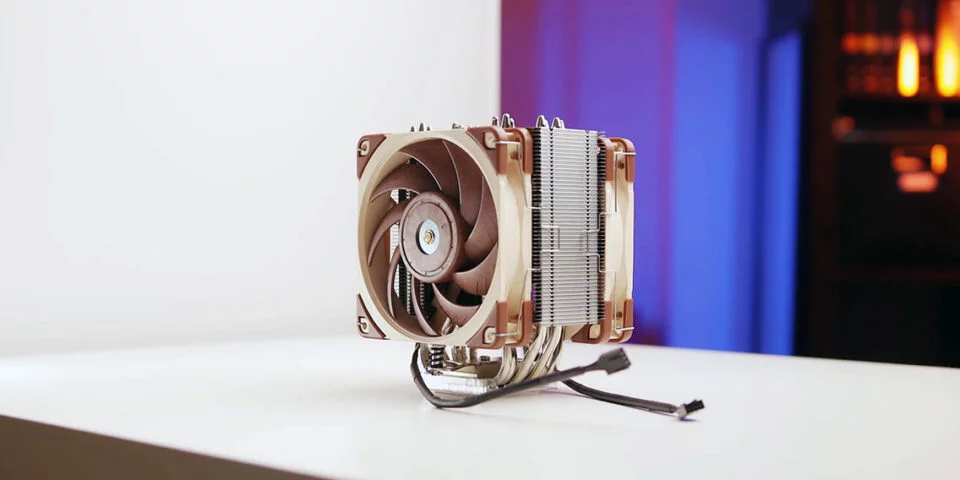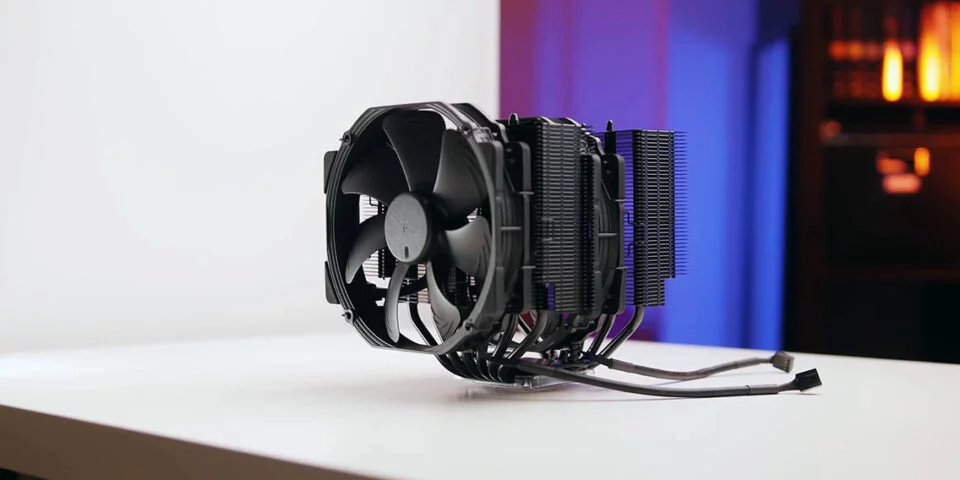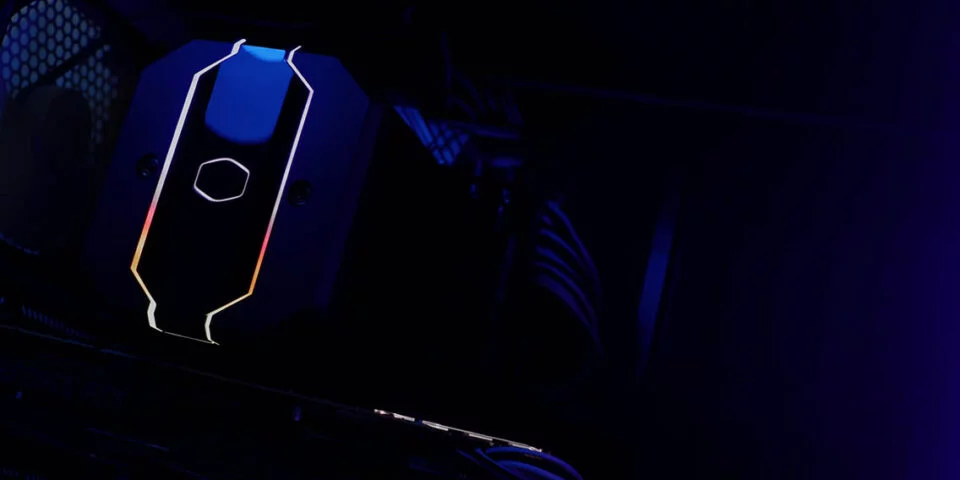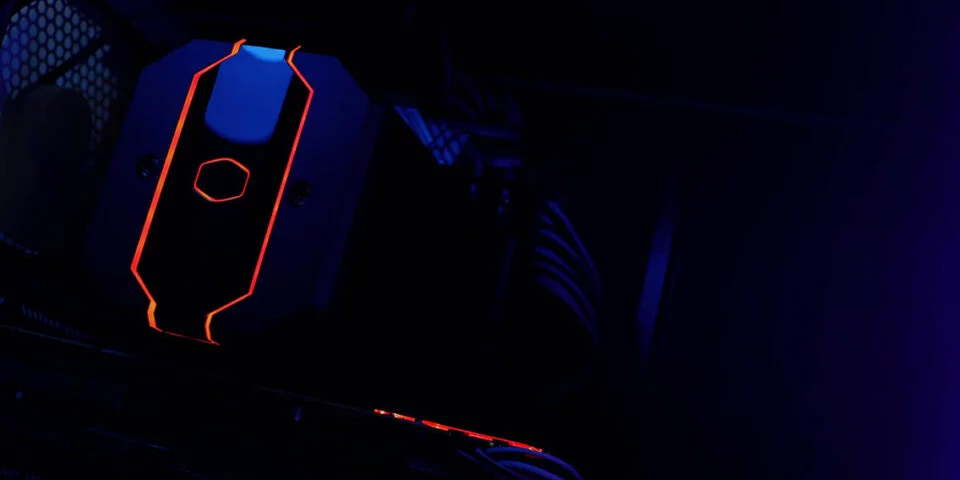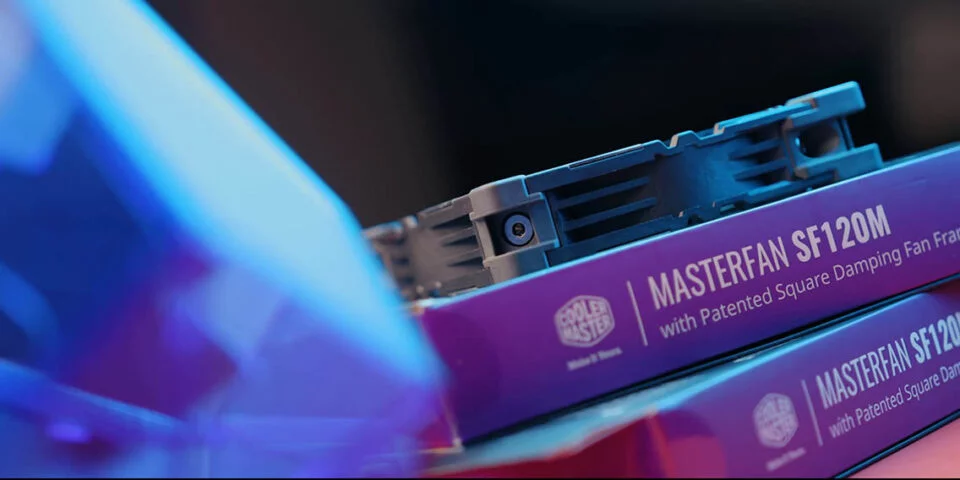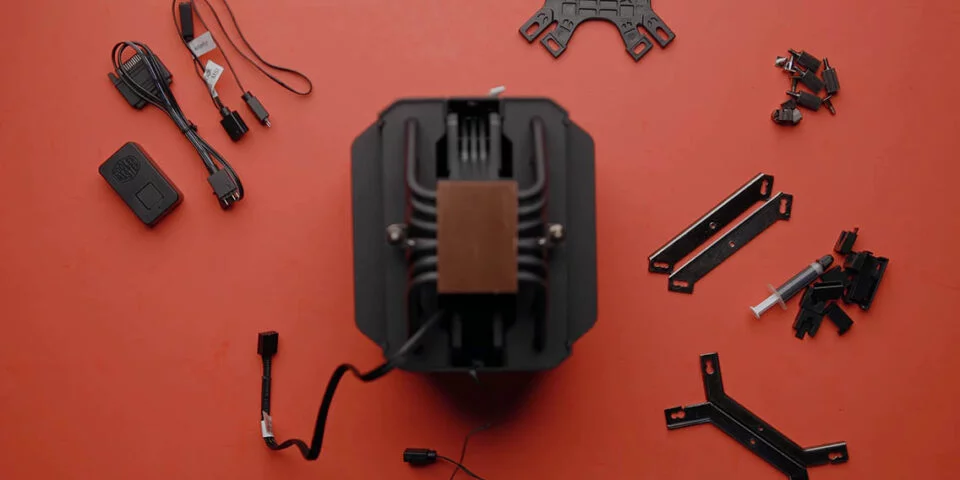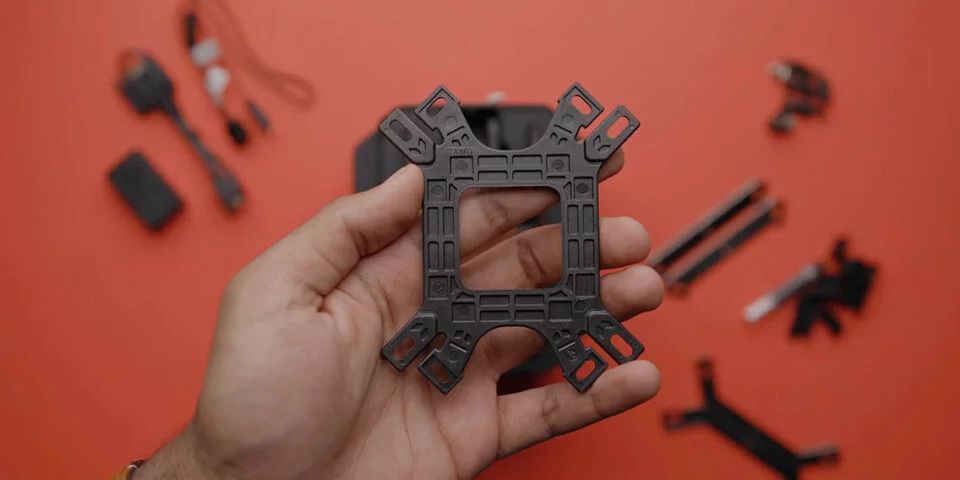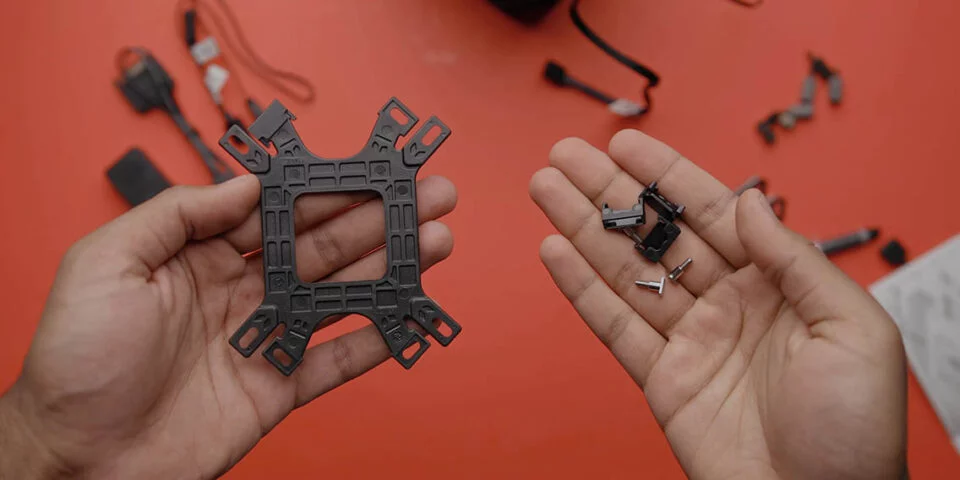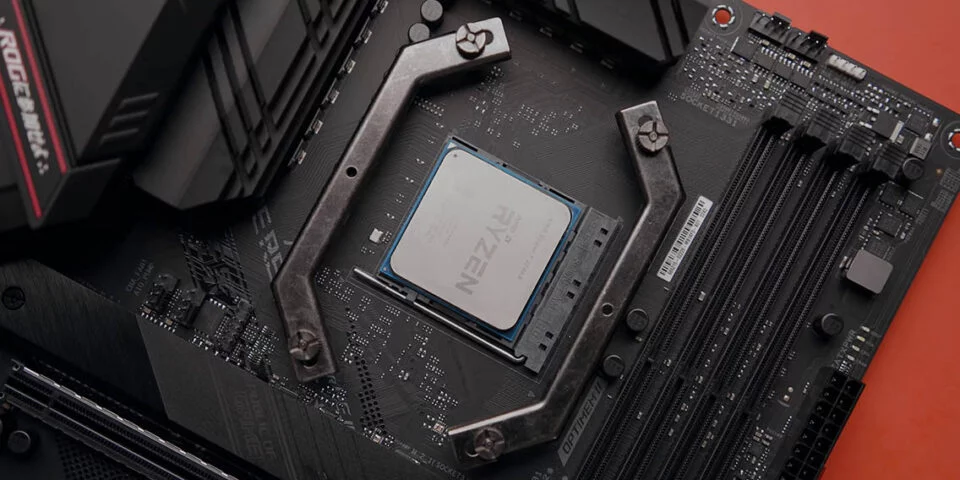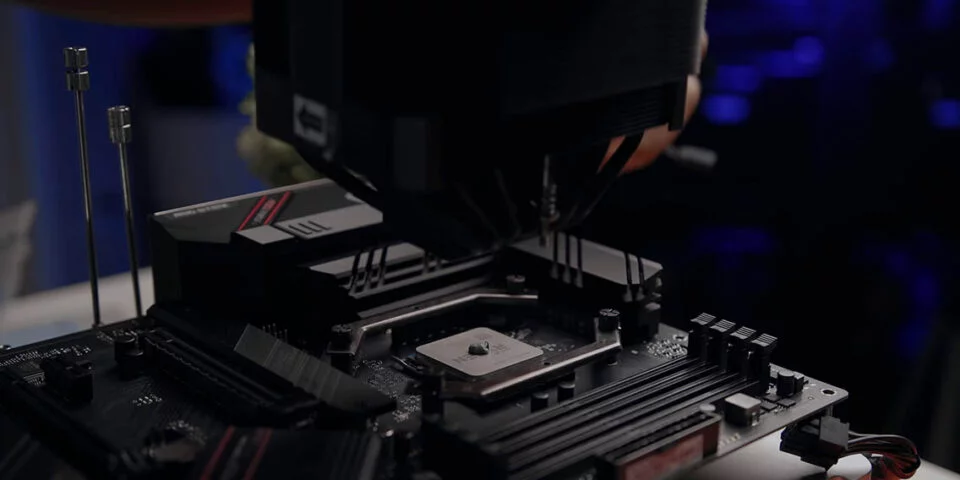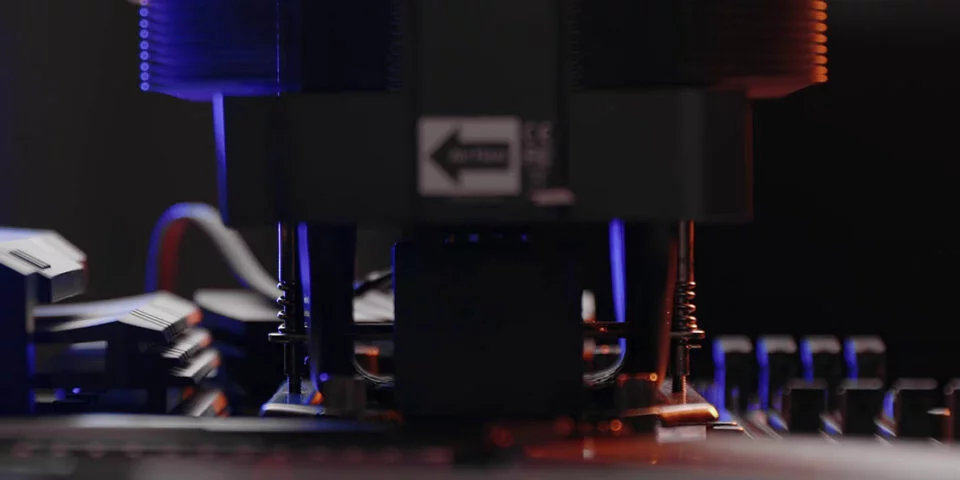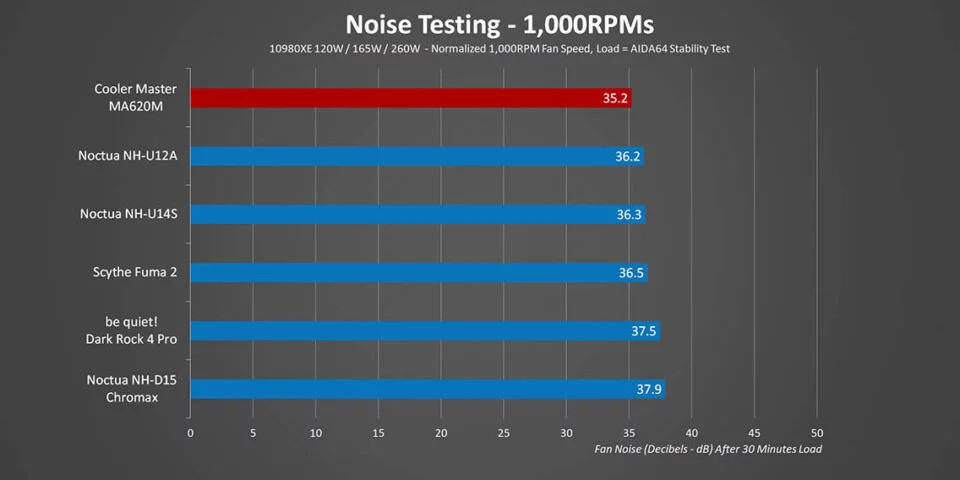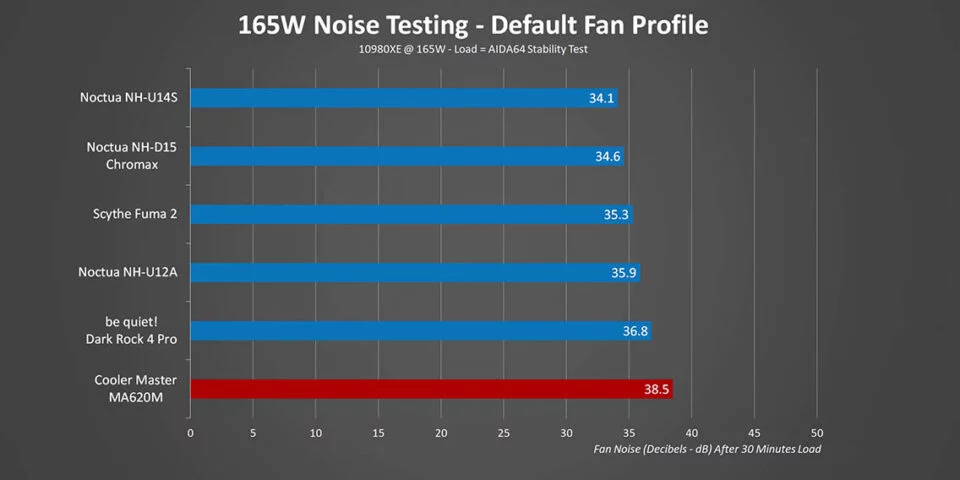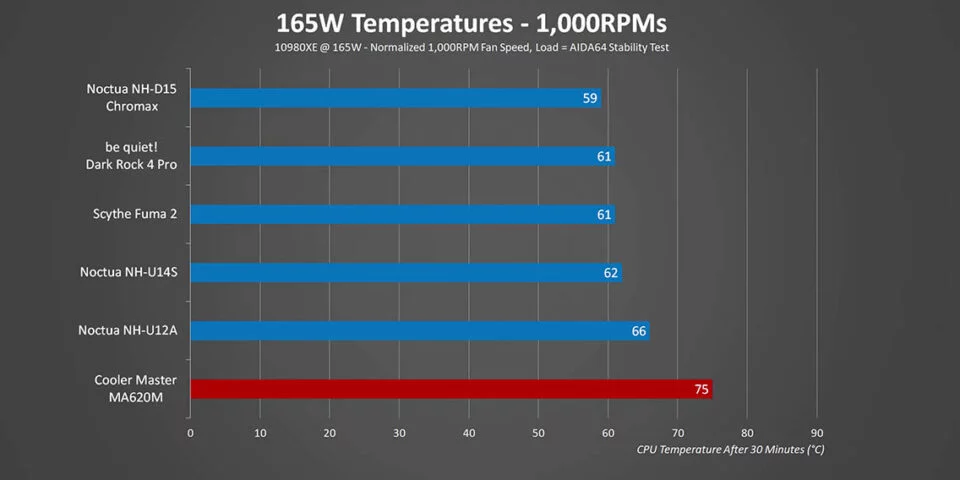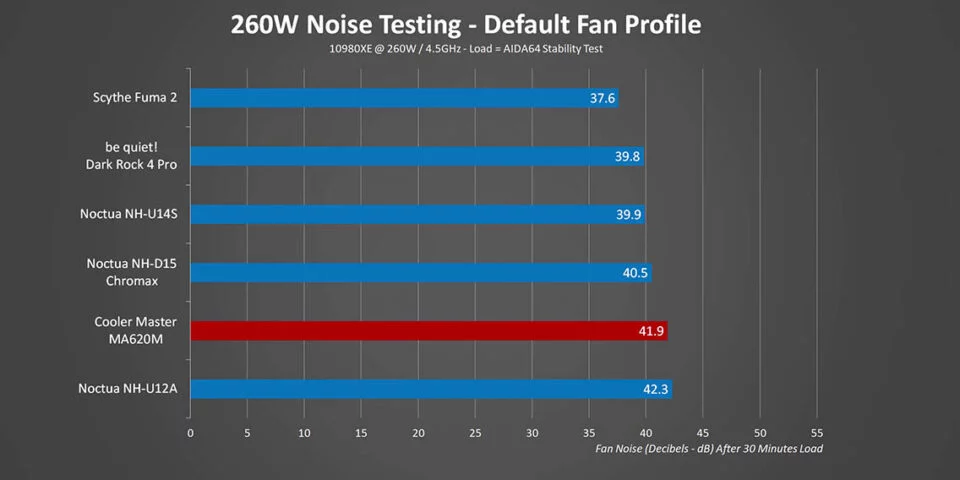An Air Cooling SURPRISE – Cooler Master MA620M CPU Air Cooler Review

Share:
It has been a really long time since we talked about air coolers. In fact, the last ones that I remember checking out were the Zalman CNPS20X and the CNPS17X, and those didn’t really turn out that great. Part of that might be due to the fact that there haven’t been that many heatsinks launched lately, so we decided to take a look at some coolers that may have been overlooked, which ultimately led us to this the Cooler Master MA620M.
New but Familiar
While the MA620M certainly looks like the Cooler Master Wraith Ripper, which was specifically designed to cool AMD’s ThreadRipper processors, it is slightly different. It doesn’t have the massive Ryzen logo or the four point mounting system needed for first generation TR4 motherboards. That origin gives this cooler a pretty solid engineering foundation since the Wraith Ripper was designed to cool off CPUs with a huge 180W to 250W TDP… Right? Well, yes and no, because Cooler Master has actually made some changes to the MA620M to make it more adaptable to every current generation system. Now it is definitely an interesting looking air cooler, but is it any good? That is the ultimate question that needs to be answered, so let’s jump into it.
Specs & Price
I’m going to get right into things and say that this isn’t a small cooler in any way, shape or form. However, it actually does look a lot larger than it is. Basically, it is a 135mm wide, 125mm long, and 165mm high, and it weighs in at a pretty heavy 1.65KG.
It also costs about a $100, but I have seen it go for as little as $90. However, when compared to the competition that is still pretty expensive. Comparing it to some of the other heatsinks that we have looked at, the big takeaway here is its height. Part of this is due to the space needed for the addressable RGB array, but you will need to take this into consideration before assuming that it will fit into your case. This is also a heavy unit at 1.65KG, so that is another thing to keep in mind. We have already seen a lot of competitors in the $100 bracket that can handle some very serious heat loads, so the MA620M is in some pretty tough company, but unlike some others Cooler Master doesn’t really mention how much of a thermal load its cooler is meant to handle. This way they will avoid an oopsie, like Corsair’s ridiculous 250W rating for the A500, but it does also mean buyers are left guessing. To be fair though, some retailer listings specify that it’s a 130W cooler, but as you will see in a bit that is super conservative.
Design
So what makes this mini Wraith Ripper so special? Well, first of all, it’s the looks. From every single angle it looks like a clean black monolith that’s blacked out with no visible fans and a super dense fin array. Personally, I think it looks great in an underrated way, and if you want some bling there is some of that too. In fact, plenty of it. And it’s pretty subtle as far as RGB lighting goes. There are two thin lines of addressable LEDs and the outline of Cooler Master’s logo, which can be controlled with the RGB software from ASUS and others provided that there is a 5V header on your motherboard. If you’re looking to retrofit this into an older system, there is an included controller that plugs into a SATA power connector, and it allows you to cycle through a few preset colors and effects.
From a more technical standpoint, this cooler has 6 continuous heat pipes, which makes their way up into two individual fin arrays. Between those arrays is a single 120mm fan that is completely hidden away by the plastic shroud. Supposedly they close the sides to help direct the airflow, but I have my doubts about that since they are exactly the same size as the fan itself. I have some concerns here too, first and foremost that single fan is an SF120R, which has respectable performance, but pushing and pulling air through this dense heatsink isn’t easy and it doesn’t have the air flow or the static pressure specs to do that at low RPMs. There are a lot of better fans for this application in Cooler Master’s own lineup, like the SF120M that delivers incredible performance at lower decibels or the MasterFan Pro Air Pressure. Swapping the fan is well not impossible, but we couldn’t find a way to do it without breaking a lot of delicate plastic beds. And that’s really disappointing since other than these almond coolers, we looked at a few months ago, this is the one heat sink that simply doesn’t allow simple fan swap without major surgery.
Swapping the fan is not impossible, but we couldn’t find a way to do it without breaking a lot of delicate plastic bits. That is really disappointing since other than the Zalman coolers we looked at a few months ago, this is the one heatsink that simply doesn’t allow simple fan swap without major surgery. The last thing I wanted to touch on was the copper base, which is pretty well finished, but it’s not polished to a mirror finish either.
Installation
Installation for this cooler centers around the single piece tower design, and it’s also one of the easiest I have come across in a long time. However, don’t follow Cooler Master’s image of applying thermal compound, it’s just a mess. For the installation there is a multifunction backplate that is used for every single socket, except Intel’s LGA2066. It also replaces AMD’s stock backplate. Given how it’s designed, the only way to orient is with the fan pointed towards the motherboard’s I/O. On the back plane you will need to find the holes which correspond with your socket, install the metal studs, and then secure them in place with plastic clamps. Personally, I think there is way too much plastic going on over here, and the backplate plus the clamps just feel cheap compared to what other companies include. I mean this heatsink weighs almost 4lbs, so you can do better than this Cooler Master.
After the backplate is in place it’s just a matter of installing the standouts and the metal retention brackets. Up until this point it is pretty straight forward, but actually getting the MA620M attached to those brackets is a major pain in the butt. While the idea behind the system is a good one, there are still issues. The two screws on the cooler’s top are actually connected to long shafts that run all the way down to threaded tips, so screwing it up is almost impossible… technically. The problem is that they are a couple of millimeters too short, so you will need to tip the heat sink, start screwing in on one side only a bit, and then press down hard on the other side to get started. Even then it’s easy to think that there is even mounting pressure on the CPU, even though there isn’t because the screws tend to spin in place. You should keep pressing down and eventually the screws will get to their locked position. This messed up installation could be what is causing poor temperatures in some of the other reviews that we have looked at. Cooler Master, if you’re watching this, it’s a great concept but I think it’s executed poorly.
Another thing I noticed is the cooler doesn’t actually sit straight on any mount, and I tried it on AM4, LGA2066, and Intel’s LGA1200. It isn’t a major issue, but once you see the off angle you just can’t unsee it.
Testing at 120W / 165W / 260W
Now on to performance, and the benchmarks are evolving again with a new test. We are still going to use the 18-core Intel Core i9-10980XE set to constant 165W and 260W power settings, but I’m adding an output of 120W too. This will allow us to better judge the performance of coolers when they are installed onto more efficient stock CPUs, like the Ryzen 3000 series or Intel’s Comet Lake processors. Not only that, but we can actually include a affordable coolers to the charts as well. As always, if you want to read a little bit more about our testing methodology, you can check it out right here.
At lower heat loads, the MA620M does really well against the other coolers, but that should be expected given its price. The motherboard doesn’t need to ramp up its fans all that much either, which makes this one of the quietest heatsinks we have ever tested. Remember, other than the NH-U14S it’s the only one here with a single fan. Moving on to more normalized fan speed testing at a 1,000 RPMs, it starts dropping behind a bit since the other coolers with their dual or 140mm setups just have more thermal mass to spare. However, at that speed it’s still really quiet, so while you are sacrificing temperatures, the MA620M stays true to its silence claim. Just remember that it will be operating at these decibel levels in other high wattage normalized fan speed tests as well. Moving up to full fan speed and I think we have hit the minimum temperature the CPU can get to under air cooling with our ambient conditions. When it’s running at full speed the SF120R isn’t quiet, as a matter of fact it’s almost as loud as the dual fan Noctua NH-D15 and the NH-U12A, but it also seems like the MA620M’s closed design baffles some of its noise as well.
Moving up to 165W, and this cooler is surprisingly able to still hang with some of the best air coolers on the market right now. However, this also meant that the single fan was operating at nearly full speed, but remember anything under 40dB is still super quiet so this is a pretty good result technically. However, reducing the fan speed to a normalized 1,000 RPMs reduces the noise, but it also starts to show this cooler’s weakness. I mean 75°C is still a really good result when trying to cool this kind of heat output, especially since it’s also the quietest here at that speed. However, for that price the other high-end heatsinks are better options. Cranking the fans to full speed isn’t something you would want to do, but temperatures get lowered drastically. Of course, this comes with a higher noise output.
Now moving the power output of our CPU to a constant 260W really separates the men from the boys. Honestly, the only coolers that really have the thermal mass to keep adequate temperatures are the Noctua NH-D15 and the be quiet! Dark Rock 4 Pro. The MA620M holds things together better than I thought it would though, but it’s also operating at a 100% in this test so it’s also one of the louder options. At a slower 1,000 RPMs you can see that Cooler Master relies on fan speeds to keep temperatures in check, and when we transition to full speed there is no difference from the default speed test since the MA620M was already running at that full speed.
Conclusion
To wrap things up, I think the Cooler Master MA620M is a mixed bag, but if you look at the good points they outweigh the bad by a long shot. First and foremost, I’m absolutely in love with the design, the clean matte black look is amazing. It’s definitely something that is unique compared to the competition. They have also implemented a tasteful edition of RGB lighting at the front, and if you don’t like it you can obviously turn it off. Everyone has their own taste, which is totally fine, so you might not be a fan of the way this cooler looks, but I suspect that a lot of you will like it. As for cooling, I was pleasantly surprised since I didn’t expect much, but it actually combined really good temperatures with low noise provided your CPU isn’t producing heat loads that would match a small nuclear reactor.
While everything looks good from a performance standpoint, Cooler Master didn’t stick the landing, because if you look at the installation procedure it can get a little bit tedious. The two long screws look simple, but you could still end up running into some mounting problems. The fact that the whole thing actually doesn’t sit straight on any socket is also disappointing. It could just be our sample, but this could also hint at some quality control issues in the future, so that is certainly something to keep in mind. I think the biggest hurdle for most people will be the MA620M’s price, because if you look at alternatives like Noctua NH-U14S or the Scythe Fuma 2, they cost less and they perform better and they also run quietly. It ultimately comes down to your choice, do you prefer something that looks better or something that costs less or something that’s a balance of the two? Once you ask those questions, I guess you will find something that fits your need.
Buy items in this review from Amazon at the links below:
Cooler Master MA620M – https://geni.us/MA620M
Noctua NH-U12S – https://geni.us/U12S
Noctua NH-U12S Chromax – https://geni.us/U12SB
Noctua NH-U12A – https://geni.us/NHU12A
Noctua NH-U14S – https://geni.us/NHU14S
Scythe Fuma 2 – https://geni.us/FUMA2
be quiet! Dark Rock Pro 4 – https://geni.us/DRP4
Check out the Corsair a100 – https://go.corsair.com/a100



